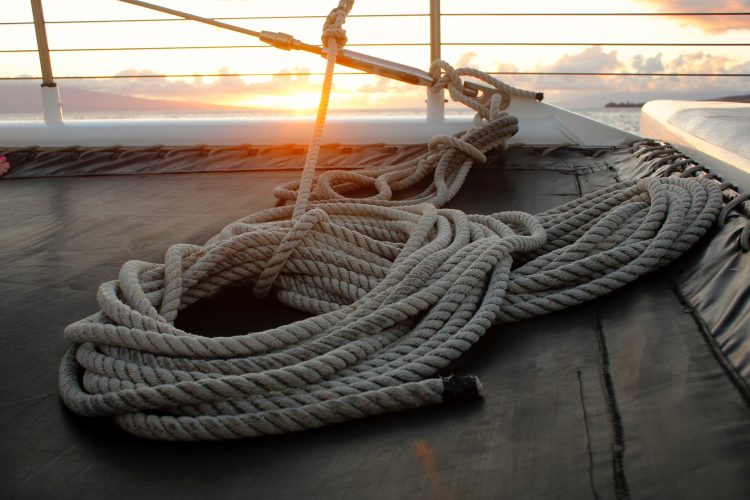Before going sailing, any boat must confirm that it has all the mandatory safety equipment and material on it.
Depending on the navigation areas that the boat has authorized, the regulations require certain equipment and safety material to be carried on board.
These equipments are divided into the following categories:
Rescue
Navigation
Dewatering
Fire protection
Miscellaneous Armament
Dirty water spillage prevention
Located, signposted and accessible to any crew member, it makes it easier to save life in an emergency.
PYROTECHNICAL MATERIAL: FLARS, ROCKETS AND SMOKE CANISTERS
Store it on board in a dry place.
Put it out of the reach of children.
Read and memorize the instructions for use, since we may need it at night, in the middle of the storm and in the dark.
Scrupulously respect the expiration dates of the mandatory material.
Otherwise you can be sanctioned.
Complement the mandatory light signals by bringing mirrors, flash lamps (stroboscopic) and chemical lights on board.
LIFE JACKETS LOCATED AND QUICKLY ACCESSIBLE FOR ALL PEOPLE ON BOARD
Lifejacket
Have at least one vest for each crew member adapted to their size, weight and age. Minors must have a life jacket to suit them, preferably with straps passed over the legs (“tantrums”).
Keep the vests in perfect condition, with clean and greased buckles, pins and closures. If they get wet with sea water, wash them with fresh water and dry them before storing.
Inflatable lifejackets must be inspected annually at an authorized Service Station. The CE regulation distinguishes four types of vests, defined by their buoyancy expressed in Newtons (N).
50 N VEST
For calm waters and close to shore. They do not guarantee that the face remains in the air at all times. They are used for sports activities, such as kayaking, jet skis or windsurfing, and are not included in the regulations of the Ministry of Public Works for use in recreational boating (Ministry of Public Works Order 1144/2003).
100 N VEST
To await an upcoming rescue, floating on calm waters.
150 N VEST
To withstand bad weather in the open sea.
275 N VEST
For extreme situations in the open sea and wearing plenty of warm clothing.
(10 Newtons = 1 Kgr of buoyant thrust)
There are many models of life jackets on the market, but all of them must have CE or SOLAS approval. All vests must have
reflective bands for a better location.
SELF-INFLATING VESTS ARE MORE COMFORTABLE BY EASIER MOVING ON BOARD. THE 150N OFFERS GREATER VERSATILITY
Vests with built-in harness (Recommended). Very practical and safe on sailing boats.
Life jackets with personal beacon (Recommended). For man overboard accidents! They are equipped with an automatic alarm and locator. In the water, they emit a signal that is captured on the bridge, helping to locate the castaway by radio direction finding.
FIGHT AGAINST FIRE
Portable fire extinguishers must always be within reach and checked, in due time and form, by authorized and approved companies. All the crew have to know their exact location and know how to use them.
In addition to the mandatory buckets for water, it is convenient to have a fire blanket with which to smother small fires.
Remember that there are five types of fire extinguishers (A, B, C, D, F) for different types of fires and that those of electrical origin are usually the most common on board.
LIFE RINGS
Lifebuoys
Lifebuoys or rings are safety elements in the case of Man overboard!
To be useful, they must be placed on the risers (fins) or aft, with light (optional floating anchor) and a quick release system and launched into the water.
The name of the boat must appear on the lifebuoy.
Also, for greater visibility, equip yourself with an IOR (International Offshore Rule) telescopic floating hanger.
IF YOU LOSE A LIFE RING, REPORT TO MARITIME SALVATION. SOMEONE CAN FIND IT AND ACTIVATE AN ALARM
For lone sailors it is advisable to tow a 50 meter line aft, topped with a visible float and with knots every five or ten meters.
However, keep in mind that, while sailing at a certain speed, even if you manage to hold on, it may not withstand the pressure of the water if the boat does not stop immediately.
Emergency boat and raft
COLLECTIVE LIFE RAISES
In order for them to fulfill their function correctly, it is important to choose the place for their installation on the roof and to comply with the deadlines for the revisions.
The entire crew must know how to unbolt and launch a raft into the sea.
OTHER SAFETY AND RESCUE ELEMENTS:
SECURITY RNÉS
It is a personal equipment adapted to the size of each crew member.
Although it may seem uncomfortable at first, the harness is important for getting around the deck in bad weather – use webbing harness instead of rope.
This prevents that, when stepping on the harness, it rolls and makes us slip.
The most complete harness is preferable, fixed to the body under the arms and between the legs.
The harness mooring line (maximum recommended length of two meters) must be finished off with two arms and two fixing carabiners.
THE SAFETY HARNESS IS NOT TO BE HELD ATTACHED TO THE BOAT IF IT FALLS OVER THE SIDE. IT IS TO NOT FALL INTO WATER. THERE IS THE IMPORTANCE OF THE HARNESS BEING SHORT LENGTH.
Safety harness to avoid falling into the water
Most harnesses are attached to the lanyard at the chest to unhook it yourself.
But if he falls into the water and is towed from the chest there is a risk of drowning.
It is preferable to fix it from the back.
Install the “lifeline” (in steel or nylon and always flat so as not to slip when stepping on it) from the bow to the cockpit, with additional fixing rings at the bottom of the cockpit and at the foot of the mast (sailing boats).
Always keep the “life line” taut.
SURVIVAL SUITS
Important for long crossings and in cold water, survival suits are difficult to put on and require training.
It is convenient to practice before boarding, until the suit can be lined up in a minute. ON BOARD KIT It is convenient to carry a first aid kit on board.
OTHER RECOMMENDED MATERIAL AND EQUIPMENT
Emergency items, Goggles, survival backpack, medical kit Goggles, tube and fins, in case you have to dive to release a line attached to the propeller or the rudder.
Have a sharp knife to cut ends.
Portable bilge pumps, in addition to the regulatory ones (with a waterway, there are never enough pumps).
Have a survival backpack ready to transport, inside a watertight drawer: the radio beacon, a portable VHF equipment, pocket knife, energy food, waterproof flashlight (batteries), cords and ropes of different sizes and lengths, garbage bags of various sizes, flares and rockets, first aid kit, drinking water, a strobe flashlight and a change of dry and warm clothes. Install a radar reflector in the highest area of your boat.
Information source: Maritime Salvage

